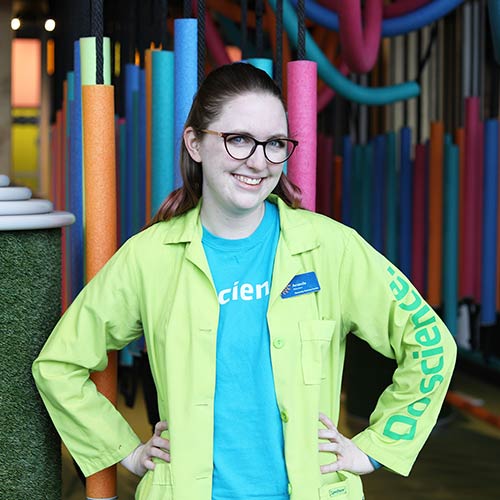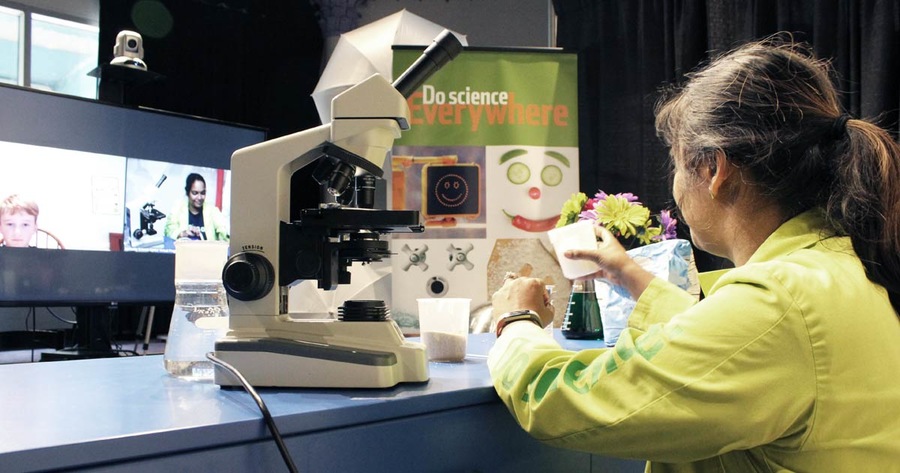With nearly a decade working in the informal education field, I've found face-to-face, hands-on programming the most rewarding. That's why I understood the importance of developing virtual content that could deliver similar results.
At the Kentucky Science Center, I develop content with a primary focus on Maker/STEAM-based traveling programs. Our methodology revolves around student-led, open-ended classes. This largely involves presenting an overarching problem for students to solve, focusing on aspects of it that interest them. Our motto is "DO Science"—we lean heavily on imparting curiosity, rather than knowledge.
As the world shut down, there was a mad scramble to find a way to directly translate our current hands-on offerings to a virtual platform. Long story short: you can't.
While frustrating, this opened the door to new opportunities, including a band-new virtual class format that presumes students have no supplies. As I set to the task, I realized I'd grown dependent on having the students do the heavy lifting in my classes. I had reached the point where I could write and teach a lesson on any science topic with a box of recyclables and basic classroom supplies. I was too comfortable. Creating classroom STEAM curriculum had become routine; a fill-in-the-blank outline of sorts that would not translate to virtual programming.
The first brainstorming sessions made me optimistic about the possibilities virtual programming would offer. I discovered about five minutes into the first virtual session that our dreams of interaction were flawed. As figures on a 2-dimensional screen, we were about as effective as a TV show asking for immediate feedback from viewers. We returned to the drawing board to reframe our expectations and methodology, asking, "How do we do interactive programming if students won't interact?" The answer was to re-evaluate our definition of "interact."
Without supplies, interaction could only primarily manifest in conversation. To avoid becoming a show-and-tell program, we needed to incorporate student interest—however it might reveal itself—and be ready to pivot at any point to follow their lead. After experimenting with a few ways to do this, we found three ways to succeed:
1. Multiple-choice, open-ended prompts.
2. Flexible content.
3. Maintaining enthusiasm.
Our multiple-choice prompts have manifested in different ways, with both successful and less successful outcomes. We found that when given too much responsibility for the flow and outcome of the program, students would withdraw. Any number of factors could influence this, but it was consistent with multiple groups. So, we limited their responsibilities. We utilize easy-to-read letters, allowing students to pick artifacts to observe or experiments to try and multiple-choice prompts in slideshows to open discussions like, "Which animal would survive in this environment best? Why?" This is more successful than relying only on verbal cues, as it allows students to type a quick, one-letter answer and us to call on them to elaborate.
My favorite virtual programming moment was during a lesson about artmaking and science. I was demonstrating a simple chromatography experiment and when I looked up from my project, the participants were gone. I assumed they'd lost interest and left. I stood there babbling for a moment, filling the emptiness until they rushed back in—with materials to follow along. I felt like my heart exploded. What was meant to be a quick, five-minute demo turned into a 15-minute exploration of the concept. They explored material alternatives and shared results with each other. I pushed aside the remainder of my planned activities, knowing they'd be much less impactful than this moment.
Learning to let go of the plan and follow student interest can be difficult, but once embraced, it frees up opportunities for greater impact. I always over-plan my lessons with little expectation of covering every bit of content.
Another huge factor in maintaining student engagement is presenter enthusiasm. Everyone has days or subjects that make them weary, and it absolutely impacts students if they're shown that. My advice is classic: Fake it 'til you make it. If you feign excitement, it becomes excitement, both for you and the students. I present programs alongside a colleague on another screen, and our methods have evolved to take advantage of this. We work off each other, fill in information gaps, and build each other's enthusiasm. Having a secondary presenter does wonders to keep up the pace of the program and enhance its engagement for all involved.
It's safe to say there is still much to learn about the world of virtual STEAM programs. However, if you keep programming active, adaptable and relevant for both students and presenters, they'll get more out of it than you'd think. I wish you the best as you go forth and "Do Science."
 Amanda Barnett, a graduate of West Texas A&M University, is the Offsite Master Educator at Kentucky Science Center and is a 2021 NAA Next Generation of Afterschool Leaders Honoree.
Amanda Barnett, a graduate of West Texas A&M University, is the Offsite Master Educator at Kentucky Science Center and is a 2021 NAA Next Generation of Afterschool Leaders Honoree.
Photo courtesy of Kentucky Science Center. Headshot courtesy of Ben Goldenberg.

